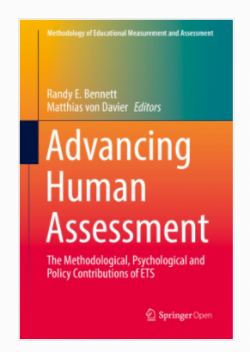Advancing Human Assessment

Book Stores
Type
E-Book
Authors
Matthias von Davier ( Randy E. Bennett; )
Category
Education-General
[ Browse Items ]
Publication Year
2017
Publisher
Springer Nature, United States
URL
[ private ]
Subject
Education, Assessment
Abstract
An edited volume on the history of the scientific contributions to educational research, psychology, and psychometrics made by the staff members of a nonprofit organization, Educational Testing Service (ETS), in Princeton, NJ, begs the questions: Why this self-inspection and who might benefit from that? The answer can be found in current developments in these fields. Many of the advances that have occurred in psychometrics can be traced to the almost 70 years of work that transpired at ETS, and this legacy is true also for select areas in statistics, the analysis of education policy, and psychology. When looking at other publications, be they conference proceedings, textbooks, or comprehensive collections like the Handbook of Item Response Theory (van der Linden 2016), the Handbook of Test Development (Lane et al. 2015), or Educational Measurement (4th ed.; Brennan 2006), one finds that many of the chapters were contributed by current and former ETS staff members, interns, or visiting scholars. We believe that this volume can do more than summarize past achievements or collect and systematize contributions. A volume that compiles the scientific and policy work done at ETS in the years since 1947 also shows the importance, and the
long-term effects, of a unique organizational form—the nonprofit measurement organization—and how that form can contribute substantially to advancing scientific knowledge, the way students and adults are assessed, and how learning outcomes and education policy more generally are evaluated. Given the volume’s purpose, we expect that it will be most attractive to those concerned with teaching, advancing, and practicing the diverse fields covered herein. It thus should make for an invaluable reference for those interested in the genesis of important lines of study that began or were significantly advanced at ETS. Contributors to this volume are current and former ETS researchers who were asked to review and synthesize work around the many important themes that the organization explored over its history, including how these contributions have affected ETS and the field beyond. Each author brings his or her own perspective and writing style to the challenge of weaving together what in many cases constitutes a prodigious body of work. Some of the resulting accounts are thematically organized, while other authors chose more chronologically oriented approaches. In some chapters, individuals loom large simply because they had such significant impact on the topic at hand, while in other accounts, there were so many contributors that substantive themes offered a more sensible organizational structure. As a result, the chapters follow no single template, but each tells its own story in its own way.
long-term effects, of a unique organizational form—the nonprofit measurement organization—and how that form can contribute substantially to advancing scientific knowledge, the way students and adults are assessed, and how learning outcomes and education policy more generally are evaluated. Given the volume’s purpose, we expect that it will be most attractive to those concerned with teaching, advancing, and practicing the diverse fields covered herein. It thus should make for an invaluable reference for those interested in the genesis of important lines of study that began or were significantly advanced at ETS. Contributors to this volume are current and former ETS researchers who were asked to review and synthesize work around the many important themes that the organization explored over its history, including how these contributions have affected ETS and the field beyond. Each author brings his or her own perspective and writing style to the challenge of weaving together what in many cases constitutes a prodigious body of work. Some of the resulting accounts are thematically organized, while other authors chose more chronologically oriented approaches. In some chapters, individuals loom large simply because they had such significant impact on the topic at hand, while in other accounts, there were so many contributors that substantive themes offered a more sensible organizational structure. As a result, the chapters follow no single template, but each tells its own story in its own way.
Biblio Notes
ISSN 2367-170X ISSN 2367-1718 (electronic)
Methodology of Educational Measurement and Assessment
ISBN 978-3-319-58687-8 ISBN 978-3-319-58689-2 (eBook)
DOI 10.1007/978-3-319-58689-2
Library of Congress Control Number: 2017949698
© Educational Testing Service 2017. This book is an open access publication
Open Access This book is licensed under the terms of the Creative Commons Attribution-NonCommercial
2.5 International License (http://creativecommons.org/licenses/by-nc/2.5/), which
permits any noncommercial use, sharing, adaptation, distribution and reproduction in any medium or
format, as long as you give appropriate credit to the original author(s) and the source, provide a link to
the Creative Commons license and indicate if changes were made.
The images or other third party material in this book are included in the book’s Creative Commons
license, unless indicated otherwise in a credit line to the material. If material is not included in the book’s
Creative Commons license and your intended use is not permitted by statutory regulation or exceeds the
permitted use, you will need to obtain permission directly from the copyright holder.
This work is subject to copyright. All commercial rights are reserved by the Publisher, whether the whole
or part of the material is concerned, specifically the rights of translation, reprinting, reuse of illustrations,
recitation, broadcasting, reproduction on microfilms or in any other physical way, and transmission or
information storage and retrieval, electronic adaptation, computer software, or by similar or dissimilar
methodology now known or hereafter developed.
The use of general descriptive names, registered names, trademarks, service marks, etc. in this publication
does not imply, even in the absence of a specific statement, that such names are exempt from the relevant
protective laws and regulations and therefore free for general use.
The publisher, the authors and the editors are safe to assume that the advice and information in this book
are believed to be true and accurate at the date of publication. Neither the publisher nor the authors or the
editors give a warranty, express or implied, with respect to the material contained herein or for any errors
or omissions that may have been made. The publisher remains neutral with regard to jurisdictional claims
in published maps and institutional affiliations.
Printed on acid-free paper
This Springer imprint is published by Springer Nature
The registered company is Springer International Publishing AG
The registered company address is: Gewerbestrasse 11, 6330 Cham, Switzerland
Methodology of Educational Measurement and Assessment
ISBN 978-3-319-58687-8 ISBN 978-3-319-58689-2 (eBook)
DOI 10.1007/978-3-319-58689-2
Library of Congress Control Number: 2017949698
© Educational Testing Service 2017. This book is an open access publication
Open Access This book is licensed under the terms of the Creative Commons Attribution-NonCommercial
2.5 International License (http://creativecommons.org/licenses/by-nc/2.5/), which
permits any noncommercial use, sharing, adaptation, distribution and reproduction in any medium or
format, as long as you give appropriate credit to the original author(s) and the source, provide a link to
the Creative Commons license and indicate if changes were made.
The images or other third party material in this book are included in the book’s Creative Commons
license, unless indicated otherwise in a credit line to the material. If material is not included in the book’s
Creative Commons license and your intended use is not permitted by statutory regulation or exceeds the
permitted use, you will need to obtain permission directly from the copyright holder.
This work is subject to copyright. All commercial rights are reserved by the Publisher, whether the whole
or part of the material is concerned, specifically the rights of translation, reprinting, reuse of illustrations,
recitation, broadcasting, reproduction on microfilms or in any other physical way, and transmission or
information storage and retrieval, electronic adaptation, computer software, or by similar or dissimilar
methodology now known or hereafter developed.
The use of general descriptive names, registered names, trademarks, service marks, etc. in this publication
does not imply, even in the absence of a specific statement, that such names are exempt from the relevant
protective laws and regulations and therefore free for general use.
The publisher, the authors and the editors are safe to assume that the advice and information in this book
are believed to be true and accurate at the date of publication. Neither the publisher nor the authors or the
editors give a warranty, express or implied, with respect to the material contained herein or for any errors
or omissions that may have been made. The publisher remains neutral with regard to jurisdictional claims
in published maps and institutional affiliations.
Printed on acid-free paper
This Springer imprint is published by Springer Nature
The registered company is Springer International Publishing AG
The registered company address is: Gewerbestrasse 11, 6330 Cham, Switzerland
Number of Copies
1
| Library | Accession No | Call No | Copy No | Edition | Location | Availability |
|---|---|---|---|---|---|---|
| Main | 704 | https://link.springer.com/book/10.1007/978-3-319-58689-2 | 1 | Yes |



